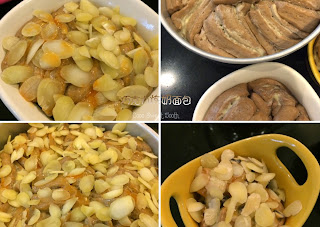 Another great recipe adapted from 周老师的美食教室𥚃的"天然手作麵包101道". If you can read Chinese, I strongly recommend getting this recipe book. Its packed with lots of great recipes and a DVD tutorial.
Another great recipe adapted from 周老师的美食教室𥚃的"天然手作麵包101道". If you can read Chinese, I strongly recommend getting this recipe book. Its packed with lots of great recipes and a DVD tutorial.
Yoghurt loaf bread is a mild flavored, non greasy, flexible sort of bread most suitable for making sandwiches. Home made yoghurt / white loaf tends to be darker in color as compared to commercial made ones, which are pale or almost white as some are made with bleaching additives. The higher the gluten in the flour mixture the darker the color of the bread. This is more so when the bread is free from milk.
The adding of white vinegar or lemon into the bread mixture can also be used to create an whiter looking bread for better appeal. To me, nothing compares to bread in its natural form and shade.
Conventionally, loaf bread is baked in a lidded bread mould mould but in this case, I am opting for making one without the lid. When the dough is given more room to proof to its fullest, it tends to produce a softer and fluffier bread while at the same time saving electricity with shorter baking time and lower heat.
(Recipe for 1x900g Toast)
(A)
200g Water
140g Plain Yoghurt
6g Instant Dry Yeast
575g Bread Flour
30g Castor Sugar
6g Salt
(B)
30g Unsalted Butter
Method
Combine all the ingredients (A) into the bowl of a stand mixer with dough hook and mix with lower speed until all ingredients are well combined.
Add (B) butter and continue using the mixer to knead with medium speed for another 15-20 mins. With little amount of fat and oil content, the dough tends to be sticky and tacky to handle. The dough breaks easily and is smooth as those pack with lots of fats and milk. Once you are able to stretch the dough to a thin membrane before breaking, it is considered ready for proofing. The normal window pane test may not work so well here.
Transfer the dough to a slightly greased bowl, cover bowl with either cling wrap or cloth. Allow the dough to proof under cooler room temperature not lesser than 20 Celsius degrees for 3 hours or until doubled in size. This method helps to produce a softer finer texture bread. When you are short of time, the conventional way of proofing the covered dough in a warm place (under 28 celsius degrees) for shorter proofing time of 1 hour may still be used.
Add (B) butter and continue using the mixer to knead with medium speed for another 15-20 mins. With little amount of fat and oil content, the dough tends to be sticky and tacky to handle. The dough breaks easily and is smooth as those pack with lots of fats and milk. Once you are able to stretch the dough to a thin membrane before breaking, it is considered ready for proofing. The normal window pane test may not work so well here.
Transfer the dough to a slightly greased bowl, cover bowl with either cling wrap or cloth. Allow the dough to proof under cooler room temperature not lesser than 20 Celsius degrees for 3 hours or until doubled in size. This method helps to produce a softer finer texture bread. When you are short of time, the conventional way of proofing the covered dough in a warm place (under 28 celsius degrees) for shorter proofing time of 1 hour may still be used.
Test the readiness of the dough with a finger lightly dusted with low gluten or cake flour. The dough is ready when the dough remain indented after the finger pokes into it.
Punch down the dough. Divide dough into 5 equal portions and mould it round. Let it rest for another 10 mins.
 Lightly dust the work top with bread flour, using a rolling pin, roll out each dough into a long rectangle. Roll up the the rectangular dough like a roulade and place in a well greased 14x25x10cm bread loaf pan. Tuck the ends down.
Lightly dust the work top with bread flour, using a rolling pin, roll out each dough into a long rectangle. Roll up the the rectangular dough like a roulade and place in a well greased 14x25x10cm bread loaf pan. Tuck the ends down. Repeat the same for the balance dough. I only managed to place 4 rolled bread dough into the pan. The balance 1 roll of roulade, I place it into a miniature bread mould.
Lightly cover the dough with cling wrap and prepare the dough for the second proofing under normal room temperature of not more than 28C degrees for 1 to 1-1/2 hrs or until double in size.
Preheat the oven 20 minutes before baking.
Lightly sprinkle some water over the top and bake at the lowest rack at 180C degrees for 35 - 40 mins.
Place a sheet of aluminum paper if the top browns too quickly during baking.
Remove from oven, unmould the bread from pan and place the bread loaf sideway on the cooling rack.













.jpg)
.jpg)
.jpg)












